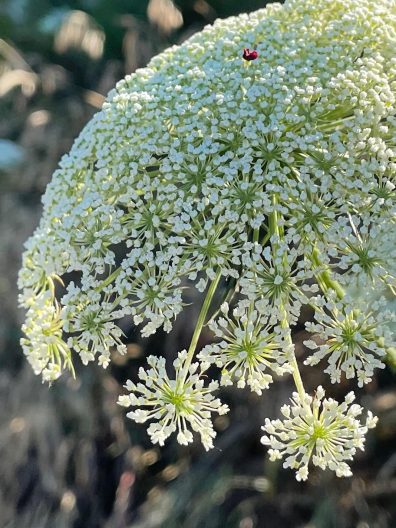
I’ve noticed that some Queen Anne’s lace flowers have a dark red spot in the center, like a flower but somewhat elevated and larger than the rest of the white ones. Does it have a purpose?
Daucus carota, the wild form of the edible carrot, is a biennial plant that forms a rosette of leaves in its first year, and an inflorescence in its second year–an umbel made up of mostly white flowers, often with the reddish purple floret (the term for a flower within an inflorescence) at the center, as you noticed.
Even the plant’s common name gave rise to tales about that red spot. In the book Wildflower Folklore by Laura C. Martin, the author mentions a story that “the queen was making lace when she pricked her finger,” and the deep red floret resembles a drop of blood. Questions about the purpose of that floret have a long history. Charles Darwin stated that it had “no functional importance,” and more recent and conflicting studies suggest that it either attracts and guides pollinators, or it repels the predations of insects. An article in Plant Species Biology (April 20, 2012), “The function of the wild carrot’s dark central floret: attract, guide or deter?,” does not dismiss the attraction or deterrence theories, finding value in both. They note that flowers that have a dark central floret tend to have fewer galls, so the floret might repel gall midges by mimicking the appearance of a gall.
Anecdotally, I have noticed that common red soldier beetles seem to like visiting—and even mating—on the umbels of Queen Anne’s lace. Whether that deep red floret attracts them because its color is similar to their own, I can’t say.